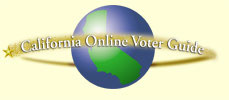California Online Voter Guide
10th Edition, March 2004 Primary Election
 About This Election
About This Election
Election results are now available.
On Tuesday, March 2, 2004, millions of Californians will head to the polls to cast ballots in hundreds of contests. Polls open at 7 a.m. and close at 8 p.m. Voters who aren't sure they can make it to the polls should sign up to get an absentee ballot to vote by mail.
If you are unsure of your voter registration status or don't know your polling place, contact your county election office. For questions about party affiliation and your primary ballot, read that section below. For more information about voting in California, see CVF's Voting FAQ; for information about voting technology, see CVF's Map of California Voting Systems and Directory of California Voting Systems.
What's on the Ballot?
Across the state, voters will choose candidates in the Presidential race, one U.S. Senate race, 53 contests for the House of Representatives, and 100 state legislative contests (including 80 State Assembly and 20 State Senate races). Also on the ballot are four statewide propositions, including two bonds and two constitutional amendments. Depending on where you live, you may have local candidates or measures on your ballot as well. CVF's California Online Voter Guide includes information about all state candidates and measures; for information on local candidates and ballot issues CVF recommends SmartVoter.
Sample Ballots
If you are a registered voter, your county registrar will mail you an Official Sample Ballot including the location of your polling place and an absentee ballot application. In addition, the Secretary of State will mail you a Voter Information Guide describing the statewide propositions and listing state candidates, and this year, a "supplemental" Voter Information Guide as well. The supplemental guide details Propositions 57 and 58, which were placed on the ballot too late to be included in the main voter guide. These three publications provide the basic information you need to prepare to vote; if you haven't received them, contact your county election office.
Party Affiliation and Voting in the Primary
If you designated a political party when registering to vote, you can only vote during this primary election for candidates of the political party to which you belong. Voters who are not affiliated with any political party may still be able to vote for partisan candidates in the primary election because three of California's seven qualified political parties -- the American Independent, Democratic, and Republican parties -- will allow unaffiliated voters to help choose their party's candidates.
If you are not affiliated with a political party but wish to participate in the American Independent, Democratic or Republican primary, you must request a partisan ballot either at the polls or on your absentee ballot request form. You may request only one party's ballot (i.e. you cannot vote for a Democrat for President and a Republican for U.S. Senate.) If you do not request a partisan ballot, you will automatically be given a ballot with only propositions and candidates for nonpartisan office. More information about party affiliation and voting is available in CVF's Voting FAQ.
Party affiliation is not a factor in voting for the propositions -- all voters regardless of party are eligible to vote for or against local and statewide ballot measures.
About This Guide
The California Online Voter Guide is an award-winning clearinghouse of election information and web site links produced by the California Voter Foundation for every statewide election since 1994. Now in its 10th edition, the 2004 guide serves up nonpartisan information on California propositions, the Presidential election, congressional races, and state legislative contests.
The initial source materials for this guide are the official Certified List of Candidates and State Voter Information Guide. CVF contacted every California legislative, congressional, Presidential, and proposition campaign to collect updated contact information and web site addresses. Candidates are listed in CVF's guide in the order they appear in the Certified List of Candidates, with the exception of Presidential and U.S. Senate candidates, who are grouped by parties listed in descending order according to their number of registrants in California.
We are interested in hearing your feedback about CVF's California Online Voter Guide. If you have suggestions, complaints, requests, or questions, please contact us.
Additional Resources
Visit CVF's Elections index page for additional election-related resources and archived California Online Voter Guides. CVF recommends the following nonpartisan web sites for additional 2004 primary election information:
This page was first published on February
12, 2004 |
Last updated on
January 27, 2006
Copyright California Voter Foundation, All Rights Reserved.

